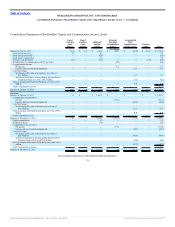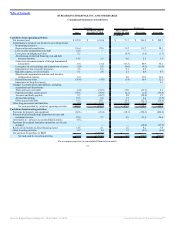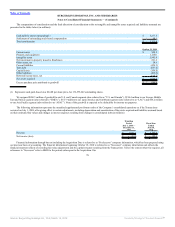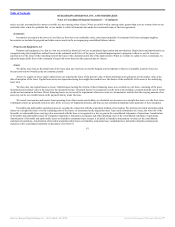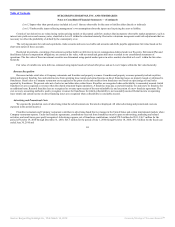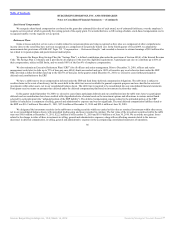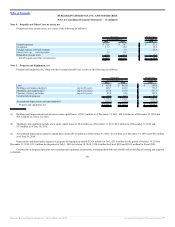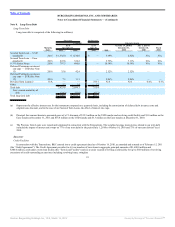Burger King 2011 Annual Report Download - page 83
Download and view the complete annual report
Please find page 83 of the 2011 Burger King annual report below. You can navigate through the pages in the report by either clicking on the pages listed below, or by using the keyword search tool below to find specific information within the annual report.
Table of Contents
BURGER KING HOLDINGS, INC. AND SUBSIDIARIES
Notes to Consolidated Financial Statements — (Continued)
Goodwill and Intangible Assets Not Subject to Amortization
Goodwill represents the excess of the purchase price over the fair value of assets acquired and liabilities assumed at December 31, 2011 recorded in
connection with the Acquisition, which was accounted for as a business combination. Additional goodwill may arise in future periods in connection with the
acquisition of franchise restaurants. Our indefinite-lived intangible asset consists of the Brand.
Goodwill and the Brand are not amortized, but are tested for impairment on an annual basis and more often if an event occurs or circumstances change that
indicates impairment might exist. During 2011, we changed our annual goodwill impairment testing date from April 1 to October 1 of each year. This change
was made to better align impairment testing procedures with the Company’s new fiscal year, related year-end financial reporting and the annual business
planning and budgeting process, which are performed during the fourth quarter of each year. As a result, the goodwill impairment testing will reflect the result of
input from business and other operating personnel in the development of the budget. If the carrying value of a reporting unit with assigned goodwill exceeds its
estimated fair value, we may be required to record an impairment charge to goodwill. We completed our goodwill and Brand impairment tests as of October 1,
2011 and no impairment resulted. The Predecessor’s goodwill and Brand impairment tests were completed as of April 1, 2010 and 2009, in accordance with our
previously established annual timeline and no impairment resulted.
When we dispose of a restaurant business within six months of acquisition, the goodwill recorded in connection with the acquisition is written off.
Otherwise, goodwill is written off based on the relative fair value of the business sold to the reporting unit when disposals occur more than six months after
acquisition. The sale of Company restaurants to franchisees is referred to as a “refranchising.”
The impairment test for the Brand consists of a comparison of the carrying value of the Brand to its fair value on a consolidated basis, with impairment, if
any, equal to the amount by which the carrying value exceeds its fair value.
Long-Lived Assets
Long-lived assets, such as property and equipment and intangible assets subject to amortization, are tested for impairment whenever events or changes in
circumstances indicate that the carrying amount of an asset may not be recoverable. Some of the events or changes in circumstances that would trigger an
impairment review include, but are not limited to, a significant under-performance relative to expected and/or historical results (two consecutive years of
negative comparable sales or operating cash flows); significant negative industry or economic trends; knowledge of transactions involving the sale of similar
property at amounts below the carrying value; or our expectation to dispose of long-lived assets before the end of their estimated useful lives. The impairment
test for long-lived assets requires us to assess the recoverability of long-lived assets by comparing their net carrying value to the sum of undiscounted estimated
future cash flows directly associated with and arising from use and eventual disposition of the assets. If the net carrying value of a group of long-lived assets
exceeds the sum of related undiscounted estimated future cash flows, we must record an impairment charge equal to the excess, if any, of net carrying value over
fair value.
Long-lived assets are grouped for recognition and measurement of impairment at the lowest level for which identifiable cash flows are largely independent
of the cash flows of other assets. Certain long-lived assets and related liabilities are grouped together for impairment testing at the operating market level (based
on geographic areas) in the case of the United States, Canada, the U.K. and Germany. The operating market groupings within the U.S. and Canada are
predominantly based on major metropolitan areas within the U.S. and Canada. Similarly, operating markets within the other foreign countries with large asset
concentrations (the U.K. and Germany) are
82
Source: Burger King Holdings Inc, 10-K, March 14, 2012 Powered by Morningstar® Document Research℠




